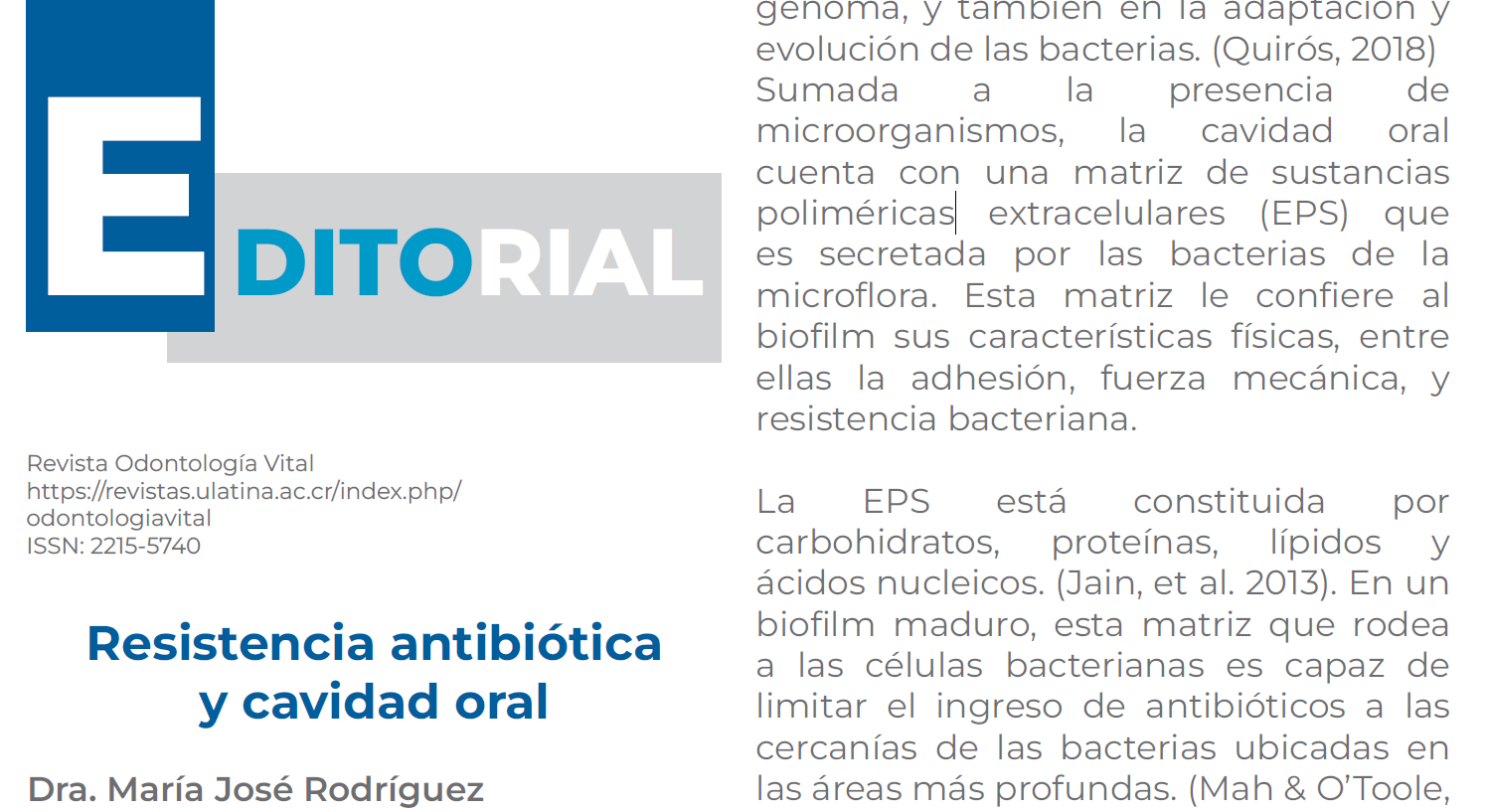Antibiotic resistance and oral cavity
DOI:
https://doi.org/10.59334/ROV.v1i37.527Keywords:
oral medicine, antibiotic resistance, antibioticsAbstract
It has been found that the structural
stability of the biofilm, as well as the
close proximity between bacterial
cells, constitutes an ideal medium
for gene transfer between the. This mechanism allows
the acquisition of DNA available in the
external environment and generates a
transcendental impact on the plasticity
of the genome, the adaptation and
evolution of bacteria. These characteristics
take on special relevance when their implications
manifest in antibiotic resistance.
Downloads
References
Auer, D.L.; Mao, X.; Anderson, A.C.; Muehler, D.; Wittmer, A.; von Ohle, C.; Wolff, D.; Frese, C.; Hiller, K.-A.; Maisch, T.; et al. (2022) Phenotypic Adaptation to Antiseptics and Effects on Biofilm Formation Capacity and Antibiotic Resistance in Clinical Isolates of Early Colonizers in Dental Plaque. Antibiotics, 11, 688. https://doi.org/10.3390/antibiotics11050688
Barrientos S., Serna F.S., Díez H., Rodríguez A. (2015) Resistencia a la amoxicilina de cepas de Streptococcus mutans aisladas de individuos con antibioticoterapia previa y sin esta. Univ Odontol. Ene-Jun; 34(72): 101-106. http://dx.doi.org/10.11144/Javeriana.uo34-72.rac
Brooks L., Narvekar U., McDonald A., & Mullany P. (2022). Prevalence of antibiotic resistance genes in the oral cavity andmobile genetic elements that disseminate antimicrobial resistance: A systematic review. Molecular Oral Microbiology, 37,133– 153. https://doi.org/10.1111/omi.12375
Buonavoglia, A.; Leone, P.; Solimando, A.G.; Fasano, R.; Malerba, E.; Prete, M.; Corrente, M.; Prati, C.; Vacca, A.; Racanelli, V. (2021) Antibiotics or No Antibiotics, That Is the Question: An Update on Efficient and Effective Use of Antibiotics in Dental Practice. Antibiotics , 10, 550. https://doi.org/10.3390/antibiotics10050550
Fariña, N. (2016). Resistencia bacteriana: un problema de salud pública mundial de difícil solución. Memorias del Instituto de Investigaciones en Ciencias de la Salud, 14(1), 04-05. https://dx.doi.org/10.18004/Mem.iics/1812-9528/2016.014(01)04-005
Jain K., Parida S., Mangwani N. et al. (2013) Isolation and characterization of biofilm-forming bacteria and associated extracellular polymeric substances from oral cavity. Ann Microbiol 63, 1553–1562 . https://doi.org/10.1007/s13213-013-0618-9
Mah T.F., O'Toole G.A. (2001) Mechanisms of biofilm resistance to antimicrobial agents. Trends Microbiol. Jan;9(1):34-9. https://doi.org/10.1016/S0966-842X(00)01913-2
Moraes L.C., Só M.V., Dal Pizzol Tda S., Ferreira M.B., Montagner F. (2015) Distribution of genes related to antimicrobial resistance in different oral environments: a systematic review. J Endod. Apr;41(4):434-41. https://doi.org/10.1016/j.joen.2014.12.018
Quirós, P. (2018). Los bacteriófagos como elementos de transmisión genética horizontal de resistencias a antibióticos y toxinas Stx [Tesis de doctorado no publicada]. Universitat de Barcelona
Roberts AP, Mullany P. (2010) Oral biofilms: a reservoir of transferable, bacterial, antimicrobial resistance. Expert Rev Anti Infect Ther. Dec;8(12):1441-50. https://doi.org/10.1586/eri.10.106

Published
How to Cite
Issue
Section
Categories
License
Copyright (c) 2022 María José Rodriguez

This work is licensed under a Creative Commons Attribution 4.0 International License.
Authors who publish with Odontología Vital agree to the following terms:
- Authors retain the copyright and grant Universidad Latina de Costa Rica the right of first publication, with the work simultaneously licensed under a Creative Commons Attribution 4.0 International license (CC BY 4.0) that allows others to share the work with an acknowledgement of the work's authorship and initial publication in this journal.
- Authors are able to enter into separate, additional contractual arrangements for the non-exclusive distribution of the Odontología Vital's published version of the work (e.g., post it to an institutional repository or publish it in a book), with an acknowledgement of its initial publication.
- Authors are permitted and encouraged to post their work online (e.g., in institutional repositories or on their website) prior to and during the submission process, as it can lead to productive exchanges, as well as earlier and greater citation of published work.
Métricas alternativas










